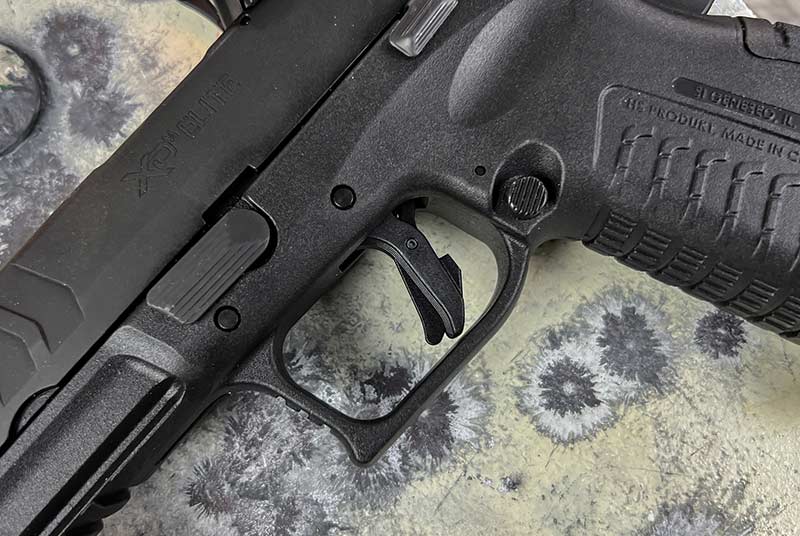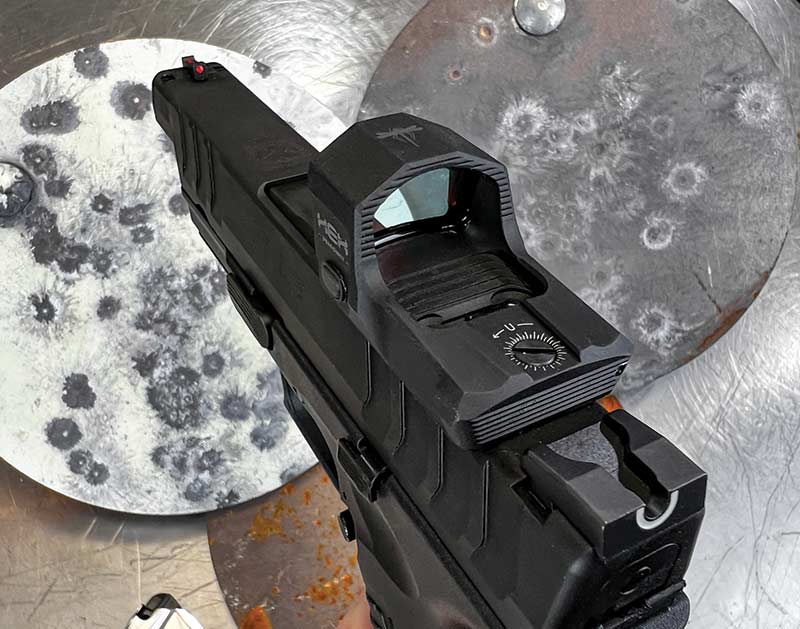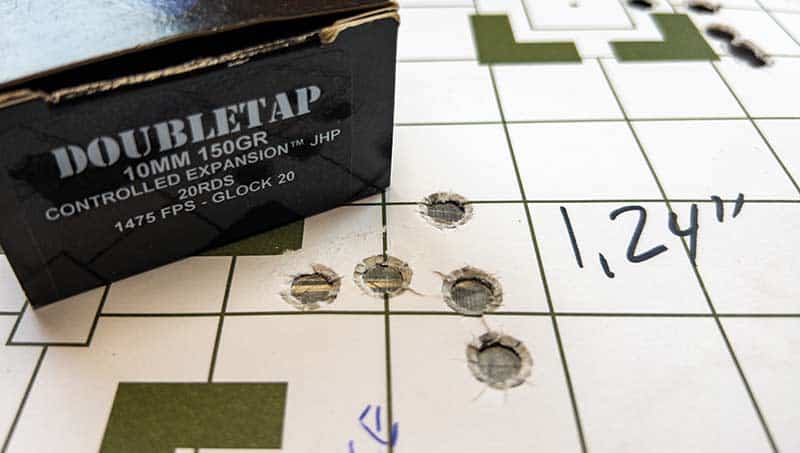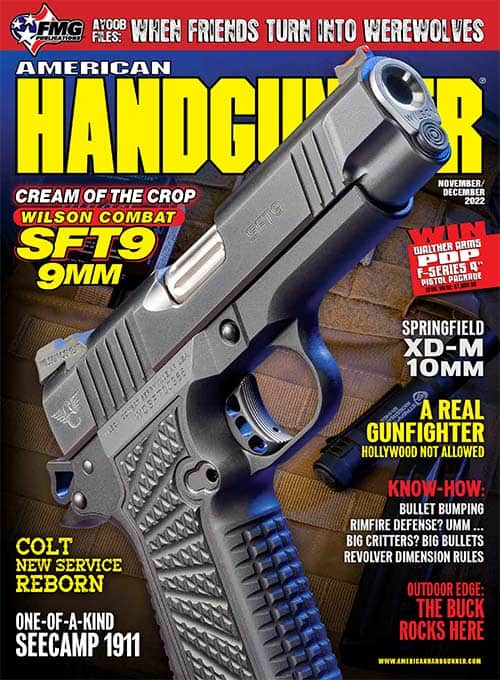Holster Full Of Boom
Springfield Armory XD-M
Reports of the demise of the 10mm cartridge have been greatly exaggerated. If new gun launches are any indicator of consumer demand (they are), then the 10mm is alive and kicking; thank you very much.
While we’re on this topic, here’s a trivia tidbit for you. That quote attributed to Mark Twain? The one about reports of his demise being greatly exaggerated? Well, that quote has itself been exaggerated. He actually said, “The report of my death was an exaggeration.” I have to admit I prefer the inaccurate and embellished version, so let’s stick with that.
Anyway, the 10mm has been coming on strong this past year. Considered mortally wounded after law enforcement everywhere moved to the .40 S&W and assumed to be dead and recycled into Shake Weights when law enforcement everywhere moved to the 9mm, it seems to be still kicking. Apparently, it’s the Michael Myers of calibers.
You may recall we looked at a nifty 1911 chambered in 10mm — the Springfield Armory Ronin in the May/June 2021 issue of Handgunner. And there have been plenty of others from various manufacturers. The only explanation for the resurrection I can come up with is … America! We like big guns and we cannot lie.
The newest caretaker of the 10mm is the XD-M Elite 4.5″ handgun from Springfield Armory.
Just The Specs
You’re likely familiar with the XD-M family of pistols. They’ve been plenty successful in the market for quite some time now. This one shares the family genes you’ve come to know and love. Hammer-forged steel barrel with a 1:16″ twist and Melonite-finish. Forged steel slide, also with Melonite treatment and a black polymer frame with aggressive grip texture molded in. As an Elite model, you’ll note a magazine well extension generously flared for fumble-free reloads. If you want a slimmer profile, it’s easily removable.
Even with the physically larger 10mm cartridges it eats, you’ll fit 16 rounds in each of the two supplied magazines. If you top off, that’s 17 rounds of 10mm punch at the ready.
As for size, you’re looking at an overall length of 7.6″, grip width of 1.2″, height of 5.75″ and unloaded weight of 31 oz.
As for holsters, you should be good to go with most any holster sized and shaped for a .45 ACP XD-M pistol of similar size.
Sights on the XD-M Elite 10mm consist of a red fiber-optic tube up front — you can easily swap this for any color you like — and what Springfield calls a Tactical Rack U-Dot in the rear. It’s a mashup between a ramped low-profile sight and one with a vertical leading edge for racking on belts, slow-moving zombies and other nearby objects. The U-Notch has a — you guessed it — U-shaped white line to guide the eye. The shape provides a bit more speed in sight acquisition with minimal, if any, loss of precision.
Controls
The XD-M Elite 10mm is an ambidextrous extravaganza. Magazine release buttons aren’t reversible; they’re already present and accounted for on both sides. The same goes with the slide lock levers; low-profile versions are located on the frame’s left and right sides. The only control not ambidextrous is the takedown lever. Being a purely administrative tool, that’s irrelevant. This pistol is designed to use with either hand out of the box.
The trigger is the newer Match Enhanced Trigger Assembly (META) system. The face is flat rather than curved like the original XD-Ms, with a subtle hook on the bottom. This one breaks at 5 lbs. To me, the travel before the break after you clear the take-up stage feels a bit shorter than the originals. The reset also seems to be a bit shorter. For a polymer gun service trigger, it’s nice. There’s no detectable grit, and the pull is constant before a clean break. A molded overtravel stop prevents unnecessary movement after the shot.
Super-Sized
You’d expect the 10mm version of the XD-M Elite to be larger than the 9mm versions, and you’d be right. With an overall cartridge length of 1.260″ compared to the 9mm’s 1.169″, the magazine well (translation: grip) will require a larger longitudinal measurement. The case diameter is also somewhat larger at 0.425″ compared to 0.391″ for the 9mm, so depending on how you want to stack cartridges in the magazine, you may need more magazine well (grip) width also.
I just happened to have a 9mm XD-M Elite sitting here, so I compared a few measurements. The 9mm maximum slide width is 1.03″ while the 10mm measures 1.072″. As for the grip, the nine measures 1.083″ while the 10mm comes in at 1.282″. As you’d expect, all of this translates to a difference in grip circumference. Measuring in the middle, with the medium grip insert installed in both pistols, I figured about 53/8″ for the 10mm and 51/8″ for the wonder nine — a one-quarter-inch difference.
Bottom line? The 10mm is nominally and noticeably larger in hand. Here’s what all those numbers mean in practical terms. I have size Large hands. With the 9mm pistol, again using medium grip inserts, my trigger finger rests on the pad with plenty of airspace between my finger and the frame. I can barely use a first joint trigger placement with minimal finger dragging on the frame. With the 10mm model, I can again get a proper finger placement using the “pad on the trigger face” placement with enough airspace between finger and frame. While I can get my first joint on the trigger, there’s too much frame contact for my preference. If I were a joint trigger puller, I’d use the small grip insert to make that work.
Optics Ready
The XD-M Elite 10mm is optics-ready out of the box. While the sights are standard height, the pistol comes with the slide pre-cut for optics installation. Just remove the included cover plate, install the correct optics adapter plate, and add the red dot of your choice. Do be aware you won’t have co-witnessing with the iron sights until you install taller irons.
This pistol arrived with a Springfield Armory Hex Dragonfly red dot sight pre-installed, so being of blurry-front sight disposition, I left it right where it was and did all shooting with the red dot. I’ve grown quite accustomed to the pistol red dots and am at the point where I shoot far better with than without them.
The Hex Dragonfly beams a 3.5 MOA red dot into your field of view. A single activation button on the left both powers the unit on or off and, with repeated presses, changes to one of eight different brightness levels. If you forget and leave it on, it’ll power off after 16 hours, so the battery is rated to last 100,000 hours. Change it every year or two, and don’t worry about it. As for mounting, the Dragonfly shares the same footprint as the Vortex Venom and Burris Fastfire. You can mount most any optic to the XD-M Elite 10mm with different plates.
Range
Before heading out to shoot, this pistol spoke to me and requested the DoubleTap diet. I get it because DoubleTap Ammunition cut their chops on beefy and boomy 10mm loads back in the day. That plan worked for me, so I rounded up an assortment of hardcast, light-for-caliber, lead-free FMJ and jacketed hollowpoint ammo, all in the black and blue boxes.
Before I broke into the premium, I tested out a practice handload I whipped up. I made this one to be a pussycat practice load, even somewhat light by .40 S&W standards. I used 6.0 grains of Vihtavuouri N320 to drive a 155-grain plated bullet. I chrony-ed this one at just 1,060 fps — a true pleasure to shoot, but the only thing 10mm about it was the cartridge case. When I shot for accuracy at 25 yards, it pleasantly surprised me, turning in a 1.14″ five-shot group. Considering I didn’t even try for precision with this batch, consider me lucky. I took this as a sign of things to come with the real stuff, so I broke out the boomier ammo.
The DoubleTap FMJ weighs in at 200 grains and zipped along from the 4.5″ barrel at an average of 1,058.3 fps. A 25-yard grouping measured 1.95″.
Next up, I went with an interesting carry load. The DT 155-grain lead-free is an all-copper bullet, and its lighter weight allowed me to break the 1,240-fps barrier by a couple of feet per second. Accuracy: 2.02″.
The Godfather of Boom at DoubleTap also makes a 200-grain hardcast load for occasions when deep penetration matters. This one clocked in at 1,149.7 fps and produced a 2.53″ group.
Last, I checked out two different controlled expansion JHP loads. The 150-grain moved at 1,357.5 fps and grouped into 1.24″. The 200-grain offering clocked 1,107 fps and produced a 1.29″ group.
I have to say I wasn’t surprised by the frequency of one-inch-plus groups. I’d reviewed a 9mm XD-M Elite model some time back and found it shot exceptionally well too.
Want a little more beef for home defense, carry, or those trips into the wild? Consider a super-sized XD-M Elite.















